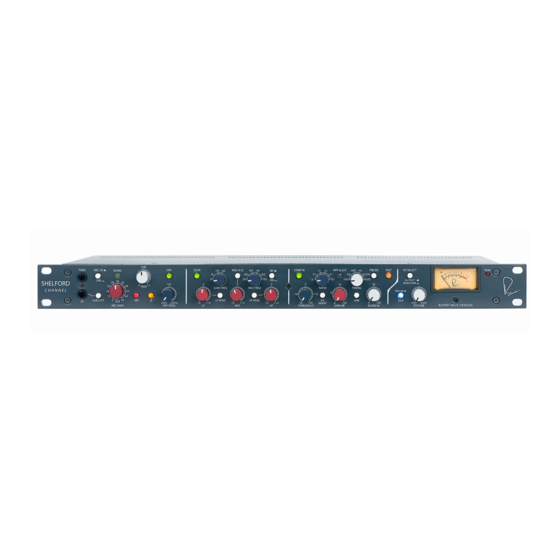Advertisement
Quick Links
Advertisement

Summary of Contents for Rupert Neve Designs Shelford Channel
- Page 1 Shelford Channel User Guide...
- Page 2 Best Practice Tips Starting Points Introduction The Shelford Channel is the culmination of over 50 years of innovative design from Rupert Neve. It features a new transformer-based, class-A microphone preamplifier, a “best-of- the-classics” inductor EQ section, a tone-packed diode bridge...
- Page 3 Front Panel Controls LOW FREQ MID HI Q 4-position rotary switch Push-button switch that reduces that selects the corner the Q width when pressed in SIGNAL TRIM (shelf) or center (peak) LED that illuminates GREEN Continuously variable frequency when signal is present and +/- 6dB level control MID FREQ RED when near clip point...
- Page 4 GAIN the wet/dry mix of the compressed 31-detent potentiometer that signal (100%) and the input signal (0%) controls the compressor Shelford Channel Model 5035 make-up gain within a range Faceplate Artwork P/N 710-00105 Rev D2 of -6dB to +20dB LINK...
- Page 5 (ex: EQ) utilized for LINE level signals P/N 710-00104 rear panel graphics rev C for Shelford Channel model 5035 chassis, P/N 430-00250 12/16/2020 DA LINE OUT -6dB OUT Main line output using a custom...
- Page 6 On Gain Staging To get maximum ‘color’ from the Shelford Channel, each section can be driven to find the harmonic ‘sweet spot’. However, it is possible to push the unit too far by moving beyond this sweet spot and into undesirable clipping distortion.
- Page 7 ‘dry’ and ‘wet’ recording to be captured simultaneously. 3. The -6dB output can be used when driving the different sections of the Shelford Channel harder to achieve larger amounts of...
- Page 8 DISCLAIMER: The following pages contain many ‘Starting Points’ for Shelford Channel settings we suggest you try with common input sources. While ‘starting points’ or ‘presets’ can certainly be useful when exploring a new piece of gear, we also encourage you to think of them merely as inspiration, not blueprints.
- Page 9 VOCALS SMOOTH MALE VOCAL – LARGE DIAPHRAGM CONDENSER MIC, SINGER 1-2 FT AWAY FROM MIC INPUT: MIC IN ---> OUTPUT: LINE OUT COMP IN: RATIO set to 2:1, THRESHOLD set to +8 to +10dB MIC GAIN: 42dB GAIN set to +6 to +7dB, TIMING set to FAST, BLEND set to 100%, FAST IN HPF IN: HPF FREQ set to ~110Hz SILK IN: RED, TEXTURE set to 25% EQ IN: LOW FREQ set to 220Hz &...
- Page 10 PUNCHY FEMALE VOCAL – LARGE DIAPHRAGM CONDENSER MIC, SINGER 1-2 FT AWAY FROM MIC INPUT: MIC IN --- OUTPUT: -6dB LINE OUT COMP IN: RATIO set to 4:1, THRESHOLD set to 0 to +2dB MIC GAIN: 48dB, TRIM set to -1dB GAIN set to 0 to +2dB, TIMING set to MS, BLEND set to 70%, FAST IN HPF IN: HPF FREQ set to ~80Hz SILK IN: RED, TEXTURE set to 75%...
- Page 11 CLEAN PASSIVE BASS – VOLUME MAX, EQ FLAT INPUT: DI --- OUTPUT: LINE OUT COMP IN: RATIO set to 2:1, THRESHOLD set to +6 to +8dB MIC GAIN: 18dB GAIN set to +8 to +10dB, TIMING set to MED HPF IN: HPF FREQ set to ~35Hz EQ IN: LOW FREQ set to 100Hz &...
- Page 12 CLEAN ELECTRIC GUITAR (SINGLE COIL) – VOLUME MAX, TONE MAX, PICKUP SELECTOR ON POSITION 1 INPUT: DI --- OUTPUT: LINE OUT Keep an eye on the VU meter and the Red MIC GAIN: 24dB, TRIM set to -3 to -4dB PEAK LED meter to avoid unwanted clipping.
- Page 13 CLEAN ACOUSTIC GUITAR (DYNAMIC MIC) – MIC POINTED AT 12 FRET, 2-3 FEET AWAY INPUT: MIC IN --- OUTPUT: LINE OUT COMP IN: RATIO set to 2:1, THRESHOLD set to 0 to +2dB MIC GAIN: 60dB GAIN set to +6 to +7dB, TIMING set to MED HPF IN: HPF FREQ set to ~80Hz SILK IN: RED, TEXTURE set to 50% EQ IN: LOW FREQ set to 220Hz &...
- Page 14 PUNCHY KICK DRUM (DYNAMIC MIC) – MIC POINTED AT RESONANT HEAD, ~1 FOOT AWAY INPUT: MIC IN --- OUTPUT: -6dB LINE OUT COMP IN: RATIO set to 3:1, THRESHOLD set to -2 to -3dB MIC GAIN: 30dB GAIN set to +4 to +5dB, TIMING set to MF EQ IN: LOW FREQ set to 100Hz &...
- Page 15 CLEAN METAL SNARE DRUM (DYNAMIC MIC) – MIC POINTED AT BATTER HEAD, ~1 FOOT AWAY INPUT: MIC IN --- OUTPUT: LINE OUT COMP IN: RATIO set to 3:1, THRESHOLD set to +2 to +4dB MIC GAIN: 36dB, TRIM set to -3 to -4dB GAIN set to 0 to +2dB, TIMING set to MED, BLEND set to 60%, FAST IN HPF IN: HPF FREQ set to 100Hz SILK IN: RED, TEXTURE set to 25%...
- Page 16 SLAPPY WOOD SNARE DRUM (DYNAMIC MIC) – MIC POINTED AT BATTER HEAD, ~1 FOOT AWAY INPUT: MIC IN --- OUTPUT: -6dB LINE OUT COMP IN: RATIO set to 4:1, THRESHOLD set to 0 to +2dB MIC GAIN: 42dB, TRIM set to +1 to +2dB GAIN set to -2 to 0dB, TIMING set to MS, BLEND set to 70%, FAST IN HPF IN: HPF FREQ set to 100Hz SILK IN: RED, TEXTURE set to 75%...
- Page 17 BALANCED MONO OVERHEAD (RIBBON MIC) – MIC ~3-5’ ABOVE THE DRUM KIT, POINTED AT TOP OF KICK DRUM INPUT: MIC IN --- OUTPUT: LINE OUT COMP IN: RATIO set to 4:1, THRESHOLD set to 0 to +2dB MIC GAIN: 42dB, TRIM set to -3 to -4dB GAIN set to 0 to +2dB, TIMING set to MED, BLEND set to 70%, FAST IN HPF IN: HPF FREQ set to ~50Hz SILK IN: RED, TEXTURE set to 75%...












Need help?
Do you have a question about the Shelford Channel and is the answer not in the manual?
Questions and answers